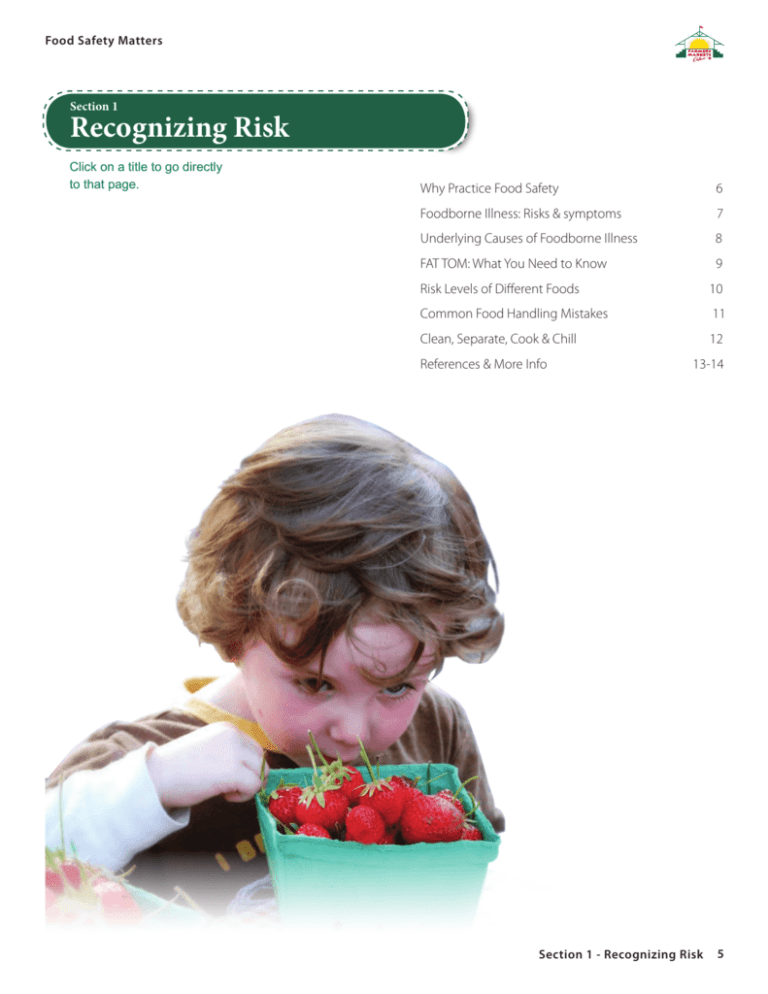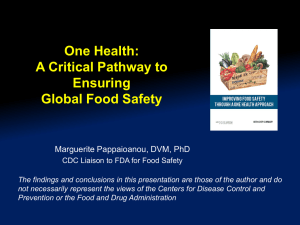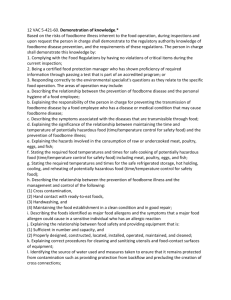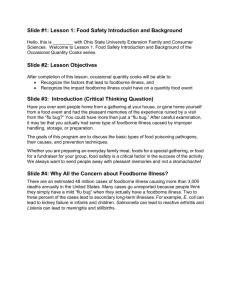Food Safety Matters
advertisement

Food Safety Matters Section 1 Recognizing Risk Click on a title to go directly to that page. Why Practice Food Safety Foodborne Illness: Risks & symptoms 6 7 Underlying Causes of Foodborne Illness 8 FAT TOM: What You Need to Know 9 Risk Levels of Different Foods 10 Common Food Handling Mistakes 11 Clean, Separate, Cook & Chill 12 References & More Info 13-14 Section 1 - Recognizing Risk 5 Food Safety Matters What You Need To Know Why Practice Food Safety In business, reputation is everything. A reputation for food safety demonstrates that you care about the quality of your product and the health of your customers. Consumers care about food safety. A poll conducted by Ipsos Reid in 2010 showed that 77% of Canadians are concerned about the safety of the food they eat. Food-safe practices: • Create a positive impression that builds customer loyalty, gains referrals and earns repeat business • Attract new business; consumers will shop at a clean market stall over a messy one • Contribute to business longevity and the bottom line • Give your business a marketing advantage, so long as you do what you claim to do • Protect the health and livelihood of all workers who handle food Handling food safely also reflects on the reputation of your local farmers’ market,* and ensures that the doors to direct marketing remain open. The alternative to handling food safely exposes your business – and potentially the entire farmers’ market – to the risk of shutdown for whatever length of time the health inspector deems appropriate. * The term “farmers’ market” refers to a seasonal, multi-vendor, community-driven (not private) organization selling agricultural, food, art and craft products including home-grown produce, home-made crafts and value-added products where the majority of vendors are primary producers (including preserves, baked goods, meat, fish, dairy products, etc. A farmers’ market has a legal obligation to enforce food safety measures. 6 Section 1 - Recognizing Risk Food Safety Matters What You Need To Know Foodborne Illness RISK & SYMPTOMS rts Public health expe e estimate that ther n are 11 to 13 millio e cases of foodborn illness in Canada every year. Typically only a small percentage of all incidents are reported. Usually people fall sick within a day or two of eating contaminated food, but symptoms can appear hours or even weeks later. Symptoms are usually flu-like and may include fever, nausea, vomiting, diarrhea and stomach cramps. In severe cases, foodborne illness can have a long-term impact on someone’s health, and occasionally, causes death. People most vulnerable to food borne illness include the elderly, children, those already in poor health and pregnant women. Section 1 - Recognizing Risk 7 Food Safety Matters What You Need To Know Underlying Causes of Foodborne Illness There are essentially three types of hazards that cause foodborne illness: physical, chemical and biological.’ Physical hazards 1. Physical hazards Hair, fingernails, wood splinters and metal fragments generate the most complaints as they are the most visible contaminants. Improper hygiene, handling and packaging makes food vulnerable to physical hazards. Chemical hazards 2. Chemical hazards Additives, allergens, pesticides, drug residue, toxins, metals and cleaning agents) generally result from cross-contamination introduced during production, processing or marketing. 3. Biological hazards Biological hazards Fungi, moulds, yeast, worms, viruses and bacteria) are microorganisms that present the greatest health risk. Improper cooking, cooling and hygiene practices, along with untreated water, soil and feces are all contributing factors. There are two main types to ge understand: spoila and pathogenic, or are pathogens which us. the most treachero Bacteria are the most serious cause of biological food-borne illness. 1. Spoilage bacteria are present when food breaks down, and cause it to smell, look and taste bad. 2. Pathogens are the bacteria most likely to cause illness or even death, and you can not see, taste or smell their disease-causing presence. 8 Section 1 - Recognizing Risk Food Safety Matters What You Need To Know FAT TOM FAT TOM is a term made up of initials representing the conditions favourable for pathogens—and decidedly unfavourable for food safety: F Food is the host that pathogens need to survive. A Acidity or alkalinity of food.* T Time is of the essence. The number of pathogens doubles every 15–20 minutes. T Temperature matters. Temperatures of 4°C/40°F to 60°C/140°F favour pathogen growth. That’s the “danger zone”. O Oxygen: Its presence or absence affects bacterial growth. (Most foodborne pathogens need oxygen to survive; botulism, however, doesn’t.) M Moisture encourages the growth of pathogens; dryness discourages it. ls of leve H p r the aline *Alk avou f p s. nd u ogen h t 4.6 a a fp 4.5 th o s of l e grow v le ic pH age Acid cour s i d less . and wth r gro i e h t If FAT TOM were a person, he’d be a sneaky master criminal who steals into your kitchen, pantry or workplace, ruins your food and spreads foodborne illness, undetected. Understanding how FAT TOM works underhandedly to ruin your food allows you to take precautionary measures and implement safe practices. Section 1 - Recognizing Risk 9 Food Safety Matters What You Need To Know Risk Levels of Different Foods All foods are not created equal when it comes to foodborne illness. Foods that are better hosts to bacteria are considered high-risk, or potentially hazardous. All foods have the potential to carry foodborne ill ness if they are no t properly handled or processed. Was h all fruits and vege tables under runn ing water before prep aring or serving. High-risk foods Lower-risk foods Hig-risk foods need to be stored in a refrigerator or freezer and should be cooked correctly at a high temperature for the proper length of time. • • • • • Meat or meat products Fish and seafood Poultry Eggs Dairy (yogurt, butter, cream, milk, cheese or products that contain them, such as quiches and cream pies) 10 Section 1 - Recognizing Risk tend to be more acidic, contain more sugar or salt and/or are low in water content. They don’t typically require refrigeration until opened. • • • • • • • Lower risk foods include: Breads, buns and most baked goods Fresh fruits and vegetables Pickles and vinegars Candies Jams, jellies and preserves Syrups, honey Food Safety Matters What You Need To Know Common Food HandlingMistakes ion Cross-contaminat poor can occur through , production, storage g transport, processin tices. and marketing prac Most Common Mistakes Poor personal hygiene, and in particular, poor hand washing practices are a common, yet easily rectified oversight when handling food. Poor sanitation of equipment, utensils and food contact surfaces allows the transfer and growth of bacteria. Poor temperature control is another common mistake—either by exposing food to the danger zone from 4°C/40°F to 60°C/140°F, or by incorrect cooking or reheating practices, or by using inappropriate thawing methods or chilling practices. Section 1 - Recognizing Risk 11 Food Safety Matters What You Need To Do Clean, Separate, Cook and Chill Remembering to clean, separate, cook and chill will help you perform the best practices associated with each, found throughout this guide. These four principles are key to the prevention of foodborne illness: 1. CLEAN hands, surfaces, utensils and equipment often and thoroughly. 2. SEPARATE different types of food; keep raw meat and ready-to-eat foods separate; store similar foods together; use separate cutting boards & utensils for raw meats and produce. 3. COOK food to the correct temperature using a food probe thermometer for meats; keep hot foods hot, at 60°C/140°F or hotter until served; bring sauces, soups & gravies to a boil when reheating; heat leftovers to 74°C/165°F. 4. CHILL high-risk foods; keep cold foods cold; keep refrigerated food at 4°C/40°F or colder & frozen at -18°C/0°F or colder; for insulated coolers, use ice made from drinking water; defrost food in the fridge, under cold running water or in the microwave. Reheat food served at market once only. 12 Section 1 - Recognizing Risk Food Safety Matters What Help Is Available References & More Info Food Safety – True or False? Eat Right Ontario http://www.eatrightontario.ca/en/ViewDocument.aspx?id=12 Food Safety: Understanding Foodborne Illness Eat Right Ontario http://www.eatrightontario.ca/en/viewdocument.aspx?id=309 Food Safety Tips > Fact Sheets Canadian Partnership for Consumer Food Safety Education http://www.canfightbac.org/cpcfse/en/safety/safety_factsheets/ Bacterial Foodborne Illness in Canada: The Problem Canadian Partnership for Consumer Food Safety Education http://www.canfightbac.org/cpcfse/en/safety/safety_factsheets/foodborne_illness/ Safe Food Handling in the Home Health Canada http://www.hc-sc.gc.ca/fn-an/securit/kitchen-cuisine/interact/home-maison-eng.php Food Recall Alerts – High Risk Canadian Food Inspection Agency http://www.inspection.gc.ca/english/corpaffr/recarapp/recaltoce.shtml Causes of Foodborne Illness Canadian Food Inspection Agency http://www.inspection.gc.ca/english/fssa/concen/causee.shtml Reminding Canadians of Potential Safety Concerns in Home Canning and Bottling Health Canada, http://www.marketwire.com/press-release/Reminding-Canadians-of-Potential-Safety-Concernsin-Home-Canning-and-Bottling-1326429.htm cont’d . . . Section 1 - Recognizing Risk 13 Food Safety Matters What Help Is Available References & More Info cont’d Marketing Food Safely: Farm Direct Advantage, Chapter 3: Bad Bugs Alberta Farmers’ Market Association, 1-780-644-5377 Marketing Food Safely: Farm Direct Advantage, Chapter 5: Danger Zone Ahead Alberta Farmers’ Market Association, 1-780-644-5377 MarketSafe Student Workbook 2010, Unit 1, The Causes of Foodborne Illness Province of British Columbia, BC FOODSAFE Secretariat, Camosun College FOODSAFE and MarketSafe Resources, 1-800-663-6105 14 Section 1 - Recognizing Risk








